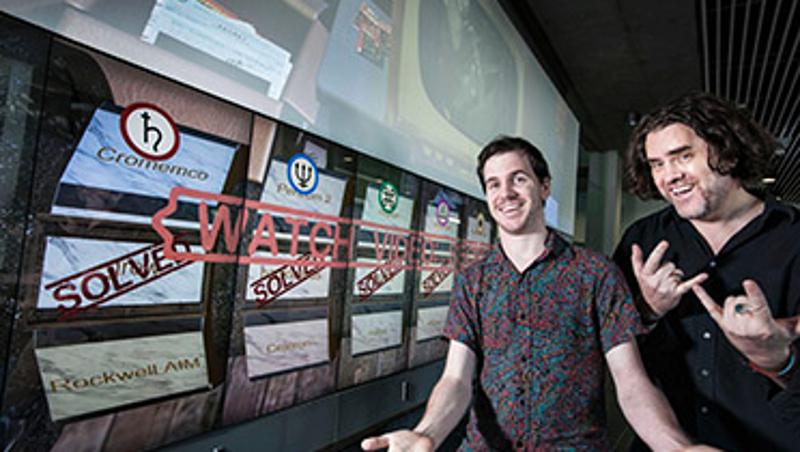
It's X Files meets HP Lovecraft - an interactive science fiction whodunit on a digital canvas that was itself considered science fiction only five years ago.
Brisbane-based digital poet Jason Nelson has created one of the world's first - and certainly the biggest - speculative fiction games ever built for large, public touchscreen displays as part of his digital writing residency at Queensland University of Technology (QUT).
Part video game, part puzzle, part electronic literature and all-interactive, Cryptext invites you to uncover the details behind a secret government program building advanced alien and supernatural technologies.
And it can be played only on the world's largest interactive, digital display space, QUT's The Cube.
"It was a real challenge, as an artist, to create interactive artwork for a truly unique space," said Dr Nelson, by day a net art and electronic literature lecturer from Griffith University College of Art.
"As a public space, I could realistically expect to capture people's attention for only a couple of minutes at a time, so I made something that provides an immediate experience and gives the player that real 'wow' moment.
"The art had to be monolithic - giant.
"This residency was new territory for me as most of my interactive art and poetry are usually works that can be sent to and shared on any screen simply by sharing the files.
"But you can't simply take this 20 by 50-foot screen home in your pocket to play later - this forced me to completely rethink my practice."
Working closely with Brisbane digital artist and game designer Matt Horton, Dr Nelson mastered a number of challenges to bring his science fiction works to life.
The Cube has no keyboards through which players give their commands, limiting the game play options. It was the pair's first experience coding for the Unity game engine. And, as The Cube is a public space, the content needed to appeal to a wide range of ages.
Cryptext is one of two works Dr Nelson produced under The Cube's second digital writing residency, which has been co-funded by QUT and the Australia Council for the Arts.
Dr Nelson also built Nomencluster, another science-inspired game in which players create kaleidoscopic art from a stream of poetic text and images of insects, 19th Century engineering engravings and food chemistry - just by touching and swiping the bank of touchscreens.
"The Cube is essentially a two-storey, public STEM (science, technology, engineering and maths) engagement tool," Dr Nelson said.
"We wanted to 'STEaM' things up by injecting art into this highly participatory interactive experience.
"By enthralling the player with the beauty of machines, the complexity of insects and the chemical mysteries of food we hope to expand the public's understanding of the poetry of science.
"While Cryptext is a free-roaming, gamified science fiction work, Nomencluster is very much more along the lines of what digital poetry is. It's a visual aesthetic - it's all about maximising the poetics of the space."
For Dr Nelson, digital poetry is about far more than the written world. It's about creating and consuming text.
"Can you write a poem in sign language? Of course you can - sign language is a text," Dr Nelson said.
"To me, each one of the images we use in the artwork is a text. The interactivity is a text, the responsiveness, the backgrounds themselves. All those things are texts that go into a digital poem.
"I think one of the great things about digital poetry, and the great differences between that and regular print poetry, is that you're engaging with the wider world as a text.
"You can read the world. You can read images. You can read interactivity, you can read interfaces, you can read giant Cube spaces - and you write for that space using all these different texts."
The public can explore the works as part of The Cube's rolling schedule of programs. Visit The Cube's website for the more details.
Visit Dr Nelson's website for more information about his residency projects.
The Cube's tech specs:
- 190 sq. metres of display surface, appox. 145 megapixels.
- Over 30 High-powered SGI graphics computers and HP servers, with a total of 64 CPUs, 64 GPUs, over 1 terabyte of RAM.
- 48 MultiTaction™ touch panels.
- 14 Panasonic high-definition projectors.
- 55 custom-made speakers.
- 4 dedicated gigabit Ethernet networks.
- Direct connection to AARNet and the internet.
- Dedicated enterprise-class data centre.
RELATED STORIES
QUT know-how puts the G20 in 'touch' with the best from Queensland
Confused about chemistry? Try this textbook on for size.
Forget Sochi - it's gold, gold, gold to the Cube!
Robots Cubed: meet the next generation of entertainment
Media contact:
Kate Haggman, QUT Media, +61 7 3138 0358, kate.haggman@qut.edu.au
After hours Rose Trapnell, +61 407 585 901


